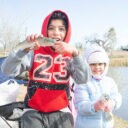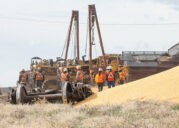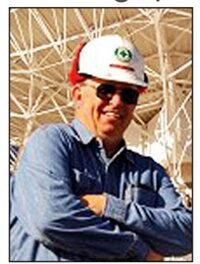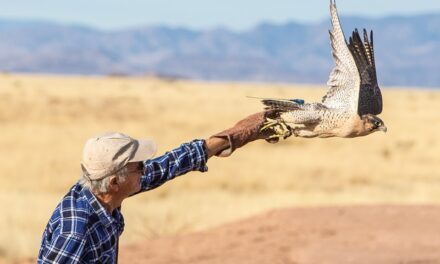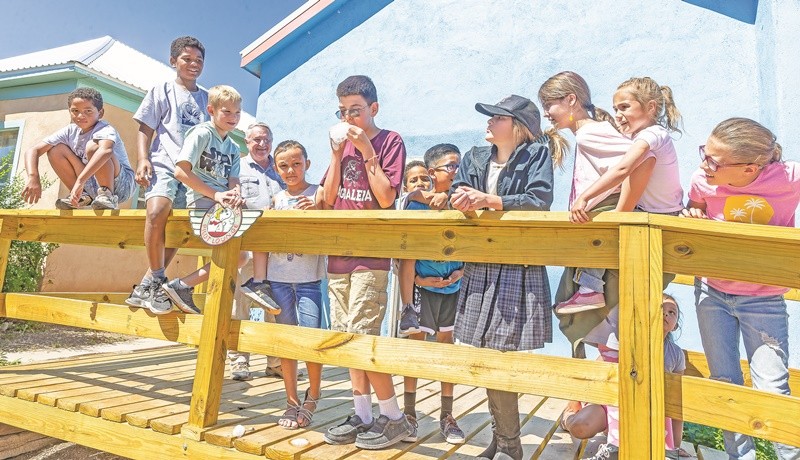
Students of the Kids Science Cafe outside the building on South Spruce Street.
Russell Huffman| El Defensor Chieftain photos
When it comes to the fun and learning going hand in hand, it’s hard to beat the Magdalena Kids’ Science Café, where the goal is to teach science, technology, engineering, and mathematics in the educational outreach program.
The Cafe is a registered STEM program identified as an after-school, out-of-school program headed by lead instructor Jim Sauer.
Sauer is in his third “23-year stage of life,” as he calls it, after having served in the U.S. Army for 23 years and retiring to become an educator for another 23.
“We’re finishing our fourth year with this program and starting our fifth in October,” Sauer said. “I’m a retired educator, retired military, and one day I’ll retire from this too. Do you want to take over because the mayor keeps asking who my replacement is? He says that there are not too many people out there that are crazy enough to do this.”
Sauer is joking because he obviously loves what he does in a classroom laden with old and new technology. As he addresses the 15 students who showed up for the Thursday class last week, it’s hard to ignore the large remote control model airplane and a six-foot-long rocket framing him overhead.
It’s no secret Sauer’s goal is to spark children’s interest in science and engineering. A sign in front of the building even says parking is only for future astronauts. He’s also passionate about twisting arms to help fund the Kids’ Science Café, which is getting a million dollars of mileage from its $5,220 yearly budget.
“The city’s doing a lot of work around our building, and they’re coming in to hit our lights next,” Sauer said. “We’ve got the only child-centered observatory in the United States out back. We teach kids to fly. The teams are working with this equipment back here. We use it to study lightning and to characterize it, and of course, they do the robotic stuff as well.”

Flint Apachito managed to get a double bubble during a Kids’ Science Café experiment.
Taking an active part in the improvements at the Kids’ Science Café is also part of the teaching curriculum.
“Work has stopped a little bit on the observatory because the teams decided instead of using AC from Socorro Electric Cooperative, they wanted to go green. So, we’ve obtained the four-by-four solar panels. We think we’ve got the voltage conditioners and the batteries now. The mayor is going to pour a concrete pad, and then the kids will do the electronics work overseen by an electrician,” Sauer said.
Failure is always an option for students. There are plenty of trial-and-error sessions with their experiments involving blowing soap bubbles which quickly jump into the forces that affect flight. The investigation to try and blow shaped bubbles with pipe cleaners is put off until different materials can be used. The underlying lesson involving surface tension disruption can easily explain how that can change the forces around flight.
“Can someone remember the forces of flight and how they work?” Sauer asks.
Hands quickly shoot up, and Magdalena kindergartener Jade Sullivan is impressive with her answer of “lift.” In rapid order succession, more students add thrust, weight, and drag to their mix of responses.
Safety is always at the front of Sauer’s mind, and he carefully gives his instructions while patiently reminding his students to be mindful of what he is talking about.
“We’re going to be making rocket fuel next,” Sauer said.
It’s not as dangerous as it sounds as he pulls out plastic photography film canisters, Alka-Seltzer and a bottle of water. What follows is several experiments involving more or less water or Alka-Seltzer and seeing how quickly the film canister shoots into the air, leading to a trip outside to see how high the canister will travel.
It’s a great combination where learning about something creates more curiosity, and the joys of failure and success meet, providing the need for more experiments.
Older students working on a WiFi-based rover can be far more involved in getting the same experience that NASA scientists deal with for their out-of-this-world work on Mars.
The Kids’ Science Café comprises two groups of students, with ages 13-17 making up the teen café and ages 5-12 making up the primary age group. The café conducts a weekly activity on most Fridays from 10 a.m. to 4 p.m. (Sauer even cooks lunch), and the teen café meets Tuesdays and Thursdays from 5-7 p.m.
During the summer, the Kids’ Science Café partners up with the Air Force Research Laboratory, Department of Defense STEM Outreach, and the Tuskegee Airmen Inc for a five-day aviation camp. Teens also participate in the Colonel Alvin Drew Aerospace Academy, which introduces students to STEM careers.
Locally, students started their first geoscience program last year from the Magdalena Ridge at New Mexico Tech’s Langmuir Laboratory. As part of the seven-day program, six teenagers conducted weather observations related to the state’s annual monsoon cycle and launched high-altitude balloons to study the nature of clouds.

